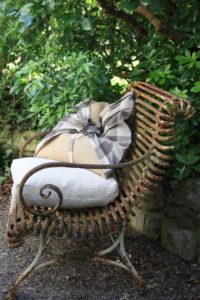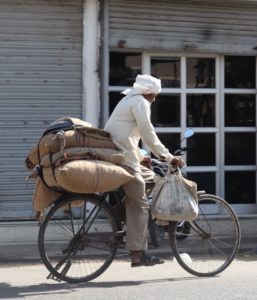 Image from Calluna : Cushions – Heather Luke
Image from Calluna : Cushions – Heather Luke
Here with a hemp linen mix seat cushion and combined with aFrench Vichy check, on an Arras metal chair in my garden.
Called burlap in the USA. A coarse, plain woven fabric made from kenaf, jute, sisal, hemp available in various weights and mostly imported from India. The name hessian seems to have come from the German state of Hessen, where the Hessian soldiers would have used the cloth as part of their uniform.
 Its strength and durability combined with breathability (resisting condensation) and low cost make hessian one of the world’s most successful cloths: it is used for sacking, particularly to transport coffee beans, grain, potatoes and for all sorts of agricultural and building use; for covering new plaster and cement, as it prevents concrete or plaster from drying out too quickly; domestically, it is used to back linoleum and carpets, and also in traditional upholstery between the frame and the horsehair.
Its strength and durability combined with breathability (resisting condensation) and low cost make hessian one of the world’s most successful cloths: it is used for sacking, particularly to transport coffee beans, grain, potatoes and for all sorts of agricultural and building use; for covering new plaster and cement, as it prevents concrete or plaster from drying out too quickly; domestically, it is used to back linoleum and carpets, and also in traditional upholstery between the frame and the horsehair.
Hessian and sacking are often confused: sacking tends to be heavier, using a thicker fibre and/or being more tightly woven. The finer weaves make interesting and inexpensive curtains and blinds in rural and contemporary rooms alike.
Image from Calluna : Cushions – Heather Luke
Hessian sacks used to over a sofa bench seat.
Coffee sacks and grain sacks, and especially the softer ones, can be re-used for fun, contemporary interior furnishings: you’ll need to buy a bundle of sacks so that you can pick and choose a bit to get around holes and eliminate scratchy ones. Do wash prior to making up to check the shrinkage. Hessian can be dyed and takes block printing and stamping.

